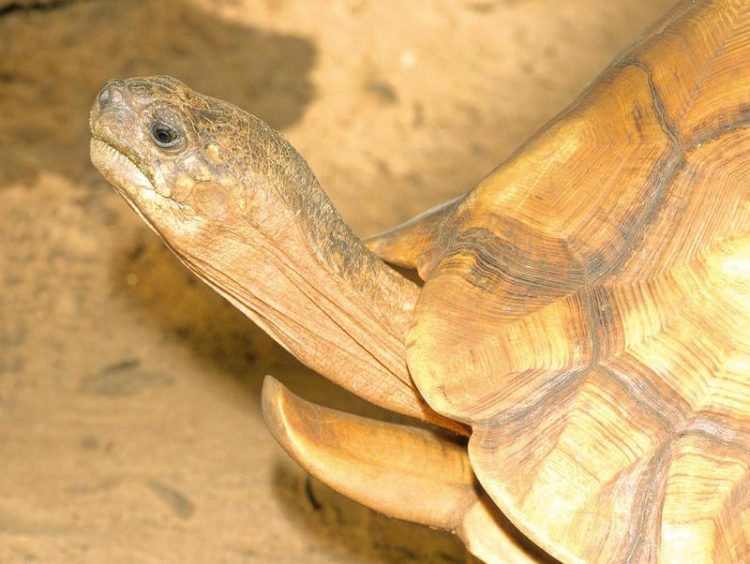Conservation assessment of Madagascar's unique reptiles: Highly threatened – not yet over the edge

One of the rarest tortoises of the world: only a few hundred specimens of the Angonoka (Astrochelys yniphora) persist in the wild in western Madagascar. Frank Glaw and Miguel Vences
Forest clearance threatens the island's snakes and lizards, whilst illegal collecting for trade and consumption heavily affects tortoises and turtles. Yet, almost of the over 370 known species have been observed recently in the wild, suggesting that few extinctions have occurred yet and that urgent and intensive conservation actions might still be able to save these unique animals. (PLoS One)
Madagascar is renowned for its unique animals and plants, most of which occur nowhere else on Earth. Few tourists leave the island without being astonished by a glimpse of its colourful chameleons, giant snakes and otherworldly leaf-tail geckos.
But the island is also a priority country for nature conservation. Most of Madagascar's wildlife, including the well-known lemurs, is affected by habitat destruction and over-collecting.
An assessment of the extinction risk of Madagascar's over 370 species of native reptiles has now been completed by national and international experts for The Red List of Threatened Species of the International Union for Conservation of Nature (IUCN).
Today, in a research paper entitled ‘Extinction Risk and the Conservation of Madagascar’s Reptiles’, the authors analysed patterns in the geographic distribution of the species and the threats facing them.
The data suggest that as many as 39% of Madagascar's reptile species are threatened with extinction. Clearance, or disturbance, of forest habitats for timber removal and expanding agriculture is the major threat to Madagascar’s snakes and lizards, including chameleons and geckos. All Malagasy species of tortoises and freshwater turtles were classed as ‘Critically Endangered’, because of escalating levels of illegal collection for international trade and human consumption.
Such new information on the status of reptiles in Madagascar is crucial to evaluating the exact role of existing protected areas as well as for prioritizing funding and conservation action.
Most importantly, the study also gives some reason for optimism. In fact, no extinctions have so far been documented – with almost all known species having been recorded in recent years in the wild. And most of them occur within the protected area network, although threats are active even in many protected sites, calling for their improved conservation.
Miguel Vences, a Madagascar reptile specialist from the University of Braunschweig in Germany, notes: “Our results highlight the importance of Madagascar’s new protected areas, created since 2003. And, given that almost no extinctions have been recorded yet, we still have the chance to save Madagascar's unique reptiles from extinction. “
Jenkins RKB, Tognelli MF, Bowles P, Cox N, Brown JL, Chan L, Andreone F, Andriamazava A, Andriantsimanarilafy RR, Anjeriniaina M, Bora P, Brady LD, Hantalalaina DF, Glaw F, Griffiths RA, Hilton-Taylor C, Hoffmann M, Katariya V, Rabibisoa NH, Rafanomezantsoa J, Rakotomalala D, Rakotondravony H, Rakotondrazafy NA, Ralambonirainy J, Ramanamanjato JB, Randriamahazo H, Randrianantoandro JC, Randrianasolo HH, Randrianirina JE, Randrianizahana H, Raselimanana AP, Rasolohery A, Ratsoavina FM, Raxworthy CJ, Robsomanitrandrasana E, Rollande F, van Dijk PP, Yoder AD, Vences M (2014): Extinction Risks and the Conservation of Madagascar’s Reptiles. PLoS ONE.
http://dx.plos.org/10.1371/journal.pone.0100173 – Quelle
http://www.zoologie.tu-bs.de/index.php/de/evolutionsbiologie/agvences
http://www.mvences.de
Media Contact
All latest news from the category: Ecology, The Environment and Conservation
This complex theme deals primarily with interactions between organisms and the environmental factors that impact them, but to a greater extent between individual inanimate environmental factors.
innovations-report offers informative reports and articles on topics such as climate protection, landscape conservation, ecological systems, wildlife and nature parks and ecosystem efficiency and balance.
Newest articles

Development of climate-neutral building materials
…through biogenic production using phototrophic microorganisms. The Fraunhofer Institute FEP in Dresden offers scalable research and development opportunities focused on technological innovations for resource conservation and climate neutrality. To meet…

New antibiotic producers described
Old DSMZ treasures with new potential. Researchers name newly described bacteria exclusively after female scientists. Researchers led by Dr Imen Nouioui and Prof. Dr Yvonne Mast from the Department Bioresources…

Nerve cells of blind mice retain their visual function
Nerve cells in the retina were analysed at TU Wien (Vienna) using microelectrodes. They show astonishingly stable behavior – good news for retina implants. The retina is often referred to…



